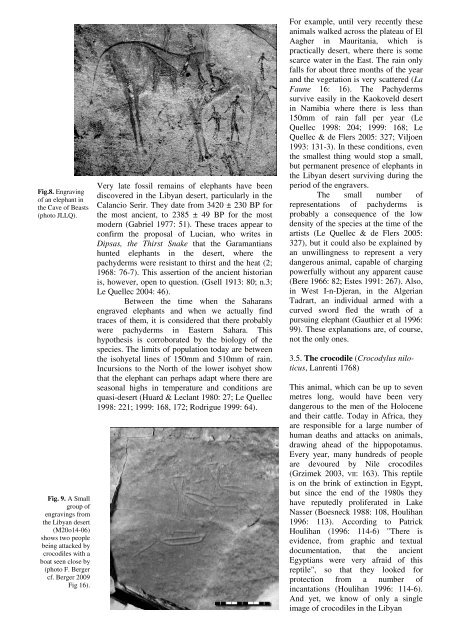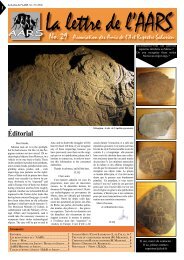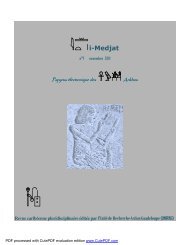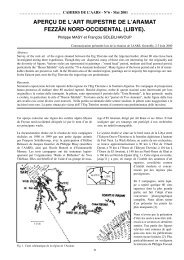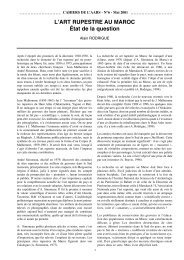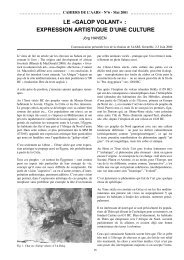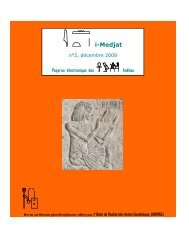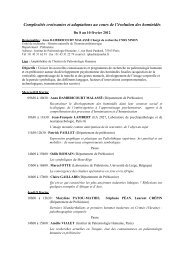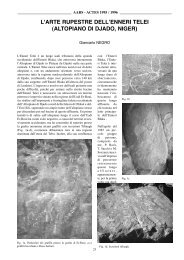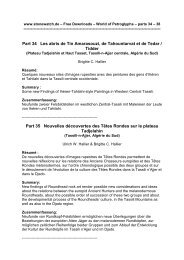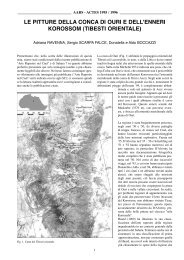From the Sahara to the Nile - Amis de l'Art rupestre saharien (AARS)
From the Sahara to the Nile - Amis de l'Art rupestre saharien (AARS)
From the Sahara to the Nile - Amis de l'Art rupestre saharien (AARS)
You also want an ePaper? Increase the reach of your titles
YUMPU automatically turns print PDFs into web optimized ePapers that Google loves.
Fig.8. Engraving<br />
of an elephant in<br />
<strong>the</strong> Cave of Beasts<br />
(pho<strong>to</strong> JLLQ).<br />
Fig. 9. A Small<br />
group of<br />
engravings from<br />
<strong>the</strong> Libyan <strong>de</strong>sert<br />
(M20o14-06)<br />
shows two people<br />
being attacked by<br />
crocodiles with a<br />
boat seen close by<br />
(pho<strong>to</strong> F. Berger<br />
cf. Berger 2009<br />
Fig 16).<br />
Very late fossil remains of elephants have been<br />
discovered in <strong>the</strong> Libyan <strong>de</strong>sert, particularly in <strong>the</strong><br />
Calancio Serir. They date from 3420 ± 230 BP for<br />
<strong>the</strong> most ancient, <strong>to</strong> 2385 ± 49 BP for <strong>the</strong> most<br />
mo<strong>de</strong>rn (Gabriel 1977: 51). These traces appear <strong>to</strong><br />
confirm <strong>the</strong> proposal of Lucian, who writes in<br />
Dipsas, <strong>the</strong> Thirst Snake that <strong>the</strong> Garamantians<br />
hunted elephants in <strong>the</strong> <strong>de</strong>sert, where <strong>the</strong><br />
pachy<strong>de</strong>rms were resistant <strong>to</strong> thirst and <strong>the</strong> heat (2;<br />
1968: 76-7). This assertion of <strong>the</strong> ancient his<strong>to</strong>rian<br />
is, however, open <strong>to</strong> question. (Gsell 1913: 80; n.3;<br />
Le Quellec 2004: 46).<br />
Between <strong>the</strong> time when <strong>the</strong> <strong>Sahara</strong>ns<br />
engraved elephants and when we actually find<br />
traces of <strong>the</strong>m, it is consi<strong>de</strong>red that <strong>the</strong>re probably<br />
were pachy<strong>de</strong>rms in Eastern <strong>Sahara</strong>. This<br />
hypo<strong>the</strong>sis is corroborated by <strong>the</strong> biology of <strong>the</strong><br />
species. The limits of population <strong>to</strong>day are between<br />
<strong>the</strong> isohyetal lines of 150mm and 510mm of rain.<br />
Incursions <strong>to</strong> <strong>the</strong> North of <strong>the</strong> lower isohyet show<br />
that <strong>the</strong> elephant can perhaps adapt where <strong>the</strong>re are<br />
seasonal highs in temperature and conditions are<br />
quasi-<strong>de</strong>sert (Huard & Leclant 1980: 27; Le Quellec<br />
1998: 221; 1999: 168, 172; Rodrigue 1999: 64).<br />
For example, until very recently <strong>the</strong>se<br />
animals walked across <strong>the</strong> plateau of El<br />
Aagher in Mauritania, which is<br />
practically <strong>de</strong>sert, where <strong>the</strong>re is some<br />
scarce water in <strong>the</strong> East. The rain only<br />
falls for about three months of <strong>the</strong> year<br />
and <strong>the</strong> vegetation is very scattered (La<br />
Faune 16: 16). The Pachy<strong>de</strong>rms<br />
survive easily in <strong>the</strong> Kaokoveld <strong>de</strong>sert<br />
in Namibia where <strong>the</strong>re is less than<br />
150mm of rain fall per year (Le<br />
Quellec 1998: 204; 1999: 168; Le<br />
Quellec & <strong>de</strong> Flers 2005: 327; Viljoen<br />
1993: 131-3). In <strong>the</strong>se conditions, even<br />
<strong>the</strong> smallest thing would s<strong>to</strong>p a small,<br />
but permanent presence of elephants in<br />
<strong>the</strong> Libyan <strong>de</strong>sert surviving during <strong>the</strong><br />
period of <strong>the</strong> engravers.<br />
The small number of<br />
representations of pachy<strong>de</strong>rms is<br />
probably a consequence of <strong>the</strong> low<br />
<strong>de</strong>nsity of <strong>the</strong> species at <strong>the</strong> time of <strong>the</strong><br />
artists (Le Quellec & <strong>de</strong> Flers 2005:<br />
327), but it could also be explained by<br />
an unwillingness <strong>to</strong> represent a very<br />
dangerous animal, capable of charging<br />
powerfully without any apparent cause<br />
(Bere 1966: 82; Estes 1991: 267). Also,<br />
in West I-n-Djeran, in <strong>the</strong> Algerian<br />
Tadrart, an individual armed with a<br />
curved sword fled <strong>the</strong> wrath of a<br />
pursuing elephant (Gauthier et al 1996:<br />
99). These explanations are, of course,<br />
not <strong>the</strong> only ones.<br />
3.5. The crocodile (Crocodylus nilo-<br />
ticus, Lanrenti 1768)<br />
This animal, which can be up <strong>to</strong> seven<br />
metres long, would have been very<br />
dangerous <strong>to</strong> <strong>the</strong> men of <strong>the</strong> Holocene<br />
and <strong>the</strong>ir cattle. Today in Africa, <strong>the</strong>y<br />
are responsible for a large number of<br />
human <strong>de</strong>aths and attacks on animals,<br />
drawing ahead of <strong>the</strong> hippopotamus.<br />
Every year, many hundreds of people<br />
are <strong>de</strong>voured by <strong>Nile</strong> crocodiles<br />
(Grzimek 2003, VII: 163). This reptile<br />
is on <strong>the</strong> brink of extinction in Egypt,<br />
but since <strong>the</strong> end of <strong>the</strong> 1980s <strong>the</strong>y<br />
have reputedly proliferated in Lake<br />
Nasser (Boesneck 1988: 108, Houlihan<br />
1996: 113). According <strong>to</strong> Patrick<br />
Houlihan (1996: 114-6) "There is<br />
evi<strong>de</strong>nce, from graphic and textual<br />
documentation, that <strong>the</strong> ancient<br />
Egyptians were very afraid of this<br />
reptile", so that <strong>the</strong>y looked for<br />
protection from a number of<br />
incantations (Houlihan 1996: 114-6).<br />
And yet, we know of only a single<br />
image of crocodiles in <strong>the</strong> Libyan


